14 Best Shopify Marketing Strategies to Increase Your Sales

Shopify provides a simple and efficient way to set up and manage online stores—this part you already know.
That’s also a reason why it’s an extremely popular platform: as of September 2025, there were over 4.2 million Shopify stores.
To see success, you need to implement some marketing tools and techniques that will help you stand out.
In this article, we’ll give you proven Shopify marketing strategies to help you increase your sales and grow your business in 2025.
In this post:
Boost Shopify conversions and sales without the big price tag
Optimize your conversions with AI product recommendations, A/B testing, web pushes, and lead capture—all at a cost-effective price. Start your 14-day trial.


More insights for Shopify store owners:
Successful Shopify stores [list with revenues]
40+ top-rated Shopify apps [for marketing and store management]
Shopify success stories from 10 stores [+tips and founder interviews]
What is Shopify marketing?
Shopify marketing refers to the various tactics and strategies used to promote and advertise a Shopify store, both on-site and across external channels. They include data-driven onsite personalization, social media engagement, automation, ethical marketing, paid advertising, retargeting, loyalty programs, and SEO.
Do Shopify strategies differ in any way from regular ecommerce marketing?
Yes and no.
Some key things to keep in mind:
Native apps. Shopify offers 8,000+ apps, third-party apps, and integrations with popular marketing tools
Built-in tools. Shopify has its own set of built-in tools and features that can be leveraged for marketing purposes (the logo maker, analytics, etc.)
Design limitations. There are certain limitations to what can be customized in terms of design and functionality (in Shopify themes, for example)
So—
On the one hand, we have certain limitations of the platform itself. On the other hand, there is a huge number of great Shopify apps. Ultimately, figuring out your Shopify marketing strategy usually means finding the right set of building blocks.
In other words, you can combine marketing tools and apps to enhance their features and create a more powerful strategy.
For example:
You can use Wisepops to capture emails (it’s a platform for generating leads “onsite”) and have them sent automatically to Klaviyo segments (to continue engaging them “offsite.”)


More combinations of tools and plugins for Shopify marketing:
Popups + email marketing. You can use a Shopify popup app to prompt visitors to sign up for your email list. Then use your email marketing tool to send targeted campaigns to those subscribers. Again, Wisepops and Klaviyo make a perfect app combo for this
Product reviews + onsite feed. Use a product review app to collect and display customer reviews on your product pages. Then show reviews in your onsite feed. A good combination for this task: Yotpo and Onsite feed
Live chat + SMS campaigns. Live chat can help you collect phone numbers from your website visitors and score leads based on their behavior. This information can then be used by an SMS app to send targeted SMS campaigns. A common set of tools would be Crisp and Postscript
How Aime generated €300K+ in attributed revenue
See an example of a Shopify marketing strategy that helped grow like never before:


ROI: €204 for every €1 spent
See how a jewelry brand on Shopify used onsite campaigns to improve visitor engagement and revenue:


Popup playbook for Shopify marketing
This playbook shows the highest-performing popup campaigns we see Shopify brands using today. Click them to see how they work.

Shopping Suggestions
Personalized recommendations displayed on your product pages

In-Page Trending Products
Show “hot right now” products in a live block

Paid Traffic Retainer
Boost ROAS with a last chance exit offer for paid traffic
Best Shopify Marketing Ideas
The best and most effective strategies for Shopify stores are:
1. Targeted popups
It is best to start maximizing your Shopify sales by making the most of customers who already visit your store. Popups are a great starting point for that.
Shopify popups can be triggered by specific events, such as clicking on a button, scrolling, or leaving a page. This makes your marketing messaging more relevant and improves personalization.
Example:
You can convert customers with personalized AI product recommendations based on their buying and browsing history and actions like adding an item to the shopping cart:


Next—
This one below is a Shopify exit popup example, the one triggered by leaving the page:


This type of campaigns converts about 4% of visitors on average + it gives Shopify stores one more chance to convert visitors before they leave.
Next—
Popups are great for sharing discount for new visitors in a multi-window welcome workflow (this one was a part of Shopify marketing strategy that increased Shopify revenue for Nutrimuscle):


And the list of use cases for ecommerce popups goes on and on, especially if you use a popup app with native Shopify campaign display properties:


Pros:
Automatically display personalized offers and discounts based on browsing or buying history, visited pages, or cart content
The most direct way to promote sales, discounts, and other offers with website visitors
You can sync your store data with your popup app that has native Shopify campaign display properties to create personalized campaigns
Easily target segments from your Klaviyo account (here's how)
Access both static and unique discount codes from your Shopify account in popup apps (here's how)
Use features like countdown timers to drive a sense of urgency
Monitor the revenue you generated with goal and revenue tracking
Use Shopify A/B testing to experiment with different marketing tactics and offers
Cons:
Some visitors may see them as intrusive and annoying
The bottom line is: use website popups in a way that enhances your customer experience. When used consistently and contextually, they can be a valuable channel for converting 4% on average and driving real, measurable revenue.
To add the first campaign to your Shopify store, use this guide with step-by-step instructions:
How to add a popup to a Shopify store [7 steps]
Or, take a look at some stores using this core Shopify marketing strategy successfully:

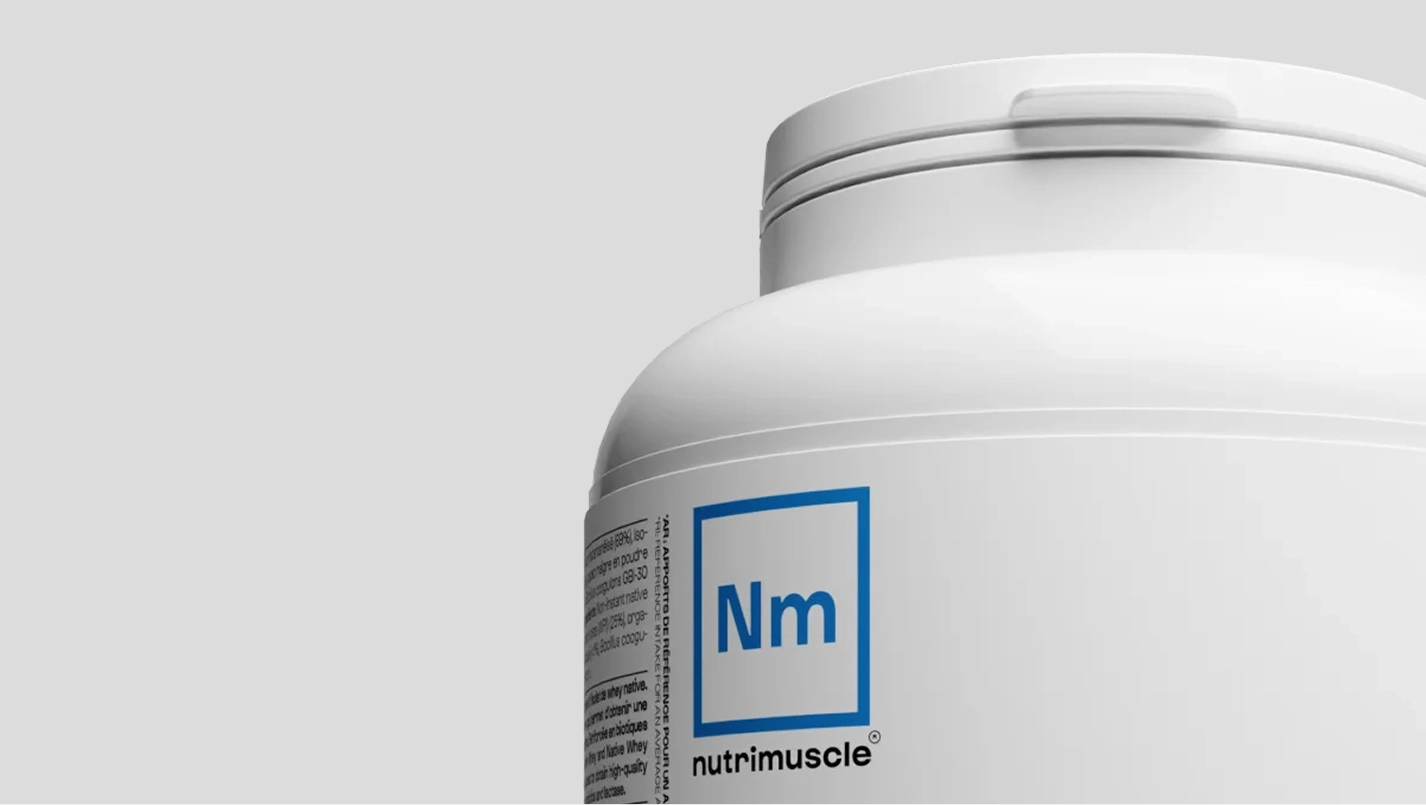
How Shopify stores engage their visitors [study]:
2. Email marketing campaigns
If using popups is the most effective Shopify marketing strategy to generate leads and collect emails, then the email marketing is crucial to nurture those leads and turn them into loyal customers.
Let’s take the MVMT (one of the digital native brands and top Shopify stores) as an example.
This store captures emails with discounts:
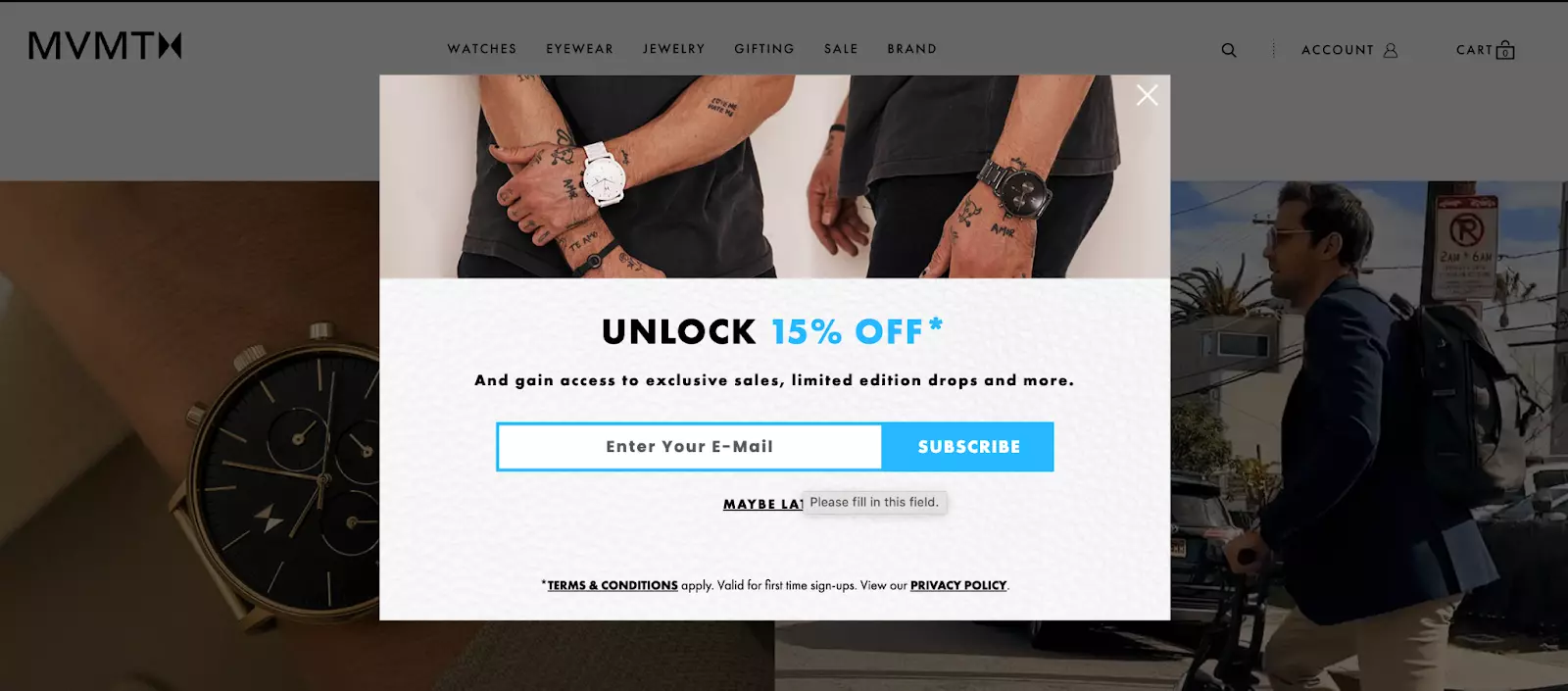

And then—
Nurtures leads with more discounts, sales promotions, new products, and special offers.
Here’s the welcome email with a discount:


(Another nice illustration of how popups and emails work together!)
Shopify offers many email marketing apps that allow you to create and send newsletters, automated emails, and targeted campaigns.
To maximize the success of your Shopify email campaigns:
Personalize your messages. Try different offers, discount sizes, recommended products, etc.
Segment your subscriber list. There should be first-time customers, repeated loyal customers, etc.
Test different CTAs. Try writing different copies, the number of CTAs, their positions in emails, etc.
Benefits:
Email is an excellent way to reach your audience
Easy to segment your email list and send targeted campaigns
You can A/B test you emails to see what’s working and what’s not
Cons:
The email inbox of your potential customers is probably already overflowing with messages from other businesses
Related guide:
3. Keep visitors engaged with a dynamic onsite feed
Getting people to visit your online store is usually neither easy nor cheap. And once they're on your website, you have to remember one thing—your store is probably just one of several pages opened in their browser.
Once they're on your site, it's important to keep their attention.
That's where the onsite feed for Shopify comes in. This feature, similar to the notification feed you see on social media, adds an extra layer of engagement to your Shopify store:


By highlighting an icon with a red dot (much like a Facebook notification) in your menu, customers will be intrigued and more likely to click.
This creates a more interactive experience for your shoppers.


You can share pretty much any marketing message through the feed to engage your visitors.
The most common Shopify campaigns include welcome messages, bestsellers, new collection announcements, and time-limited offers:


Benefits:
Instantly grabs the attention of your visitors
Works with all websites and can be added to a store in just a few clicks
Non-intrusive way to showcase featured products or promotions
Use built-in native Shopify targeting rules to create personalized campaigns
Onsite feed can significantly increase Shopify conversions and page views. Since visitors have to click on the bell to open the feed, this type of notification doesn’t interrupt the customer's browsing experience.
Example of how onsite feed as a part of Shopify marketing strategies to increase sales:
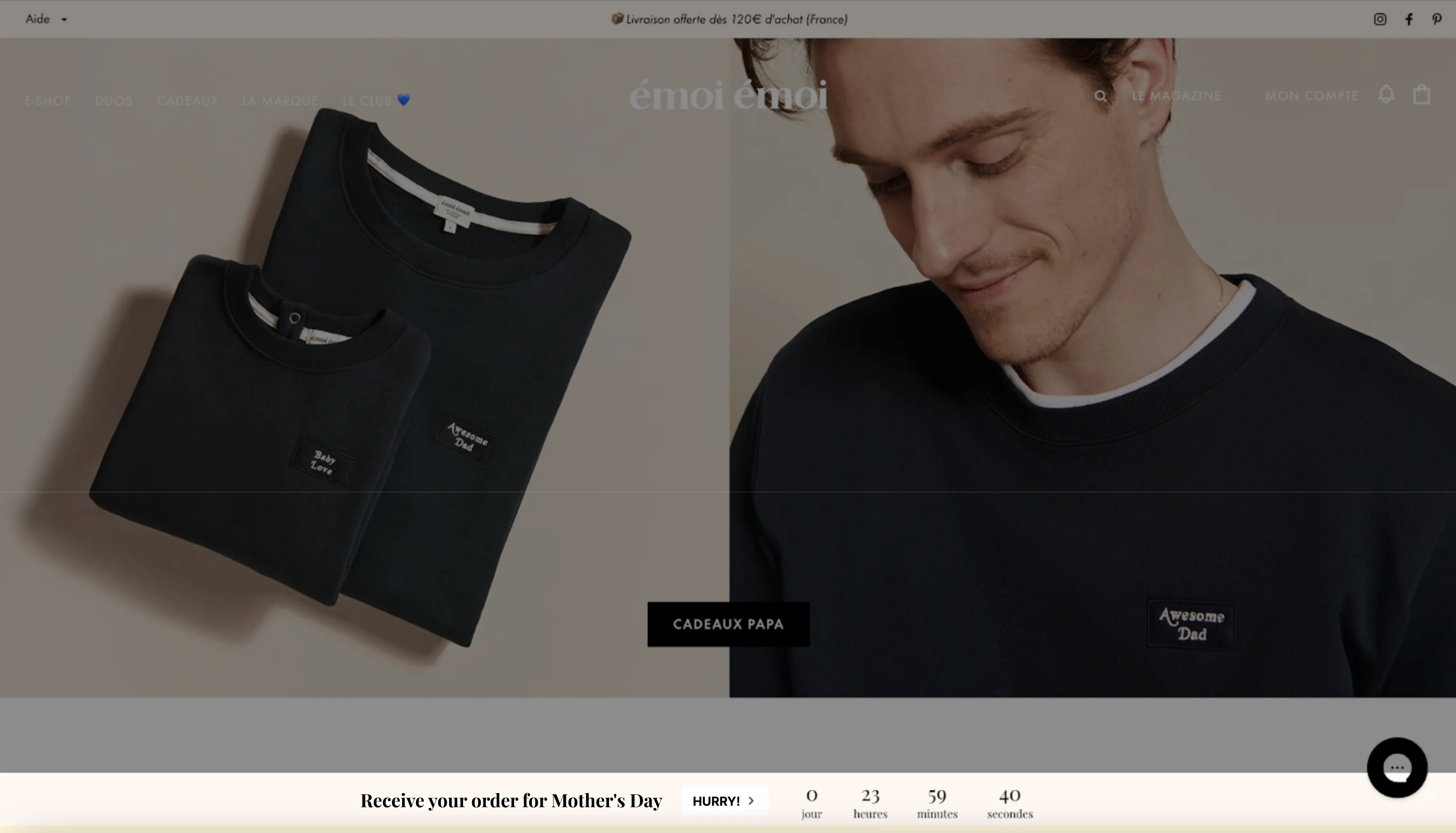

4. Social media marketing
Social media is an increasingly important platform for ecommerce businesses to reach and engage with their customers.
With billions of active users, platforms like Facebook, Instagram, and Twitter offer a huge audience for businesses to market their products and services.
Online stores engage customers in many ways there.
For example:
Look at the Rothys Instagram page’s albums: they promote new products, educate customers about materials, and share information about brand collaboration, etc.


Shopify integrates with many social media platforms, allowing you to share your products, promote sales, and run contests directly from your store. You can also use social media to drive traffic to your website and build brand awareness.
Benefits:
Huge potential audience for your products and services
Ability to target specific demographics and interests
A cost-effective way to reach a large number of people
Cons:
Maintaining a strong social media presence is time-consuming
To effectively use social media for your Shopify store, it's important to have a clear strategy in place. This includes knowing your target audience, understanding what types of content perform best on each platform, and posting engaging content on a regular basis.
Building an organic audience through Facebook, Instagram, Twitter, and TikTok takes time. But, in the long run, it is worth it.
Get some inspiration from this—
Gymshark, another top Shopify store, has become a $1 billion business thanks to a smart social media strategy.
There’s also a way to speed things up:
Paid advertising.
Social media ads can help increase the visibility of your products and drive more traffic to your Shopify website. Let’s talk about that next.
5. PPC (Pay-Per-Click) Advertising
Social media is not the only place where you can literally “buy” more traffic. The most popular platform for PPC advertising is Google Ads, which allows businesses to place ads in the sponsored section of the search engine results page.
“Paid advertising” may sound serious but even without a huge budget you should try to incorporate Google Ads into your Shopify marketing strategy. Over 50% of small businesses invest in Google search advertising.


Shopify integrates with Google’s advertising services, making it easy to create and manage your PPC campaigns directly from your store. With PPC advertising, you can target specific keywords and demographics.
Benefits:
The ability to target specific keywords and demographics
Can drive high-quality traffic to your website
Great way to test the effectiveness of your store fast
Cons:
Competition for popular keywords can be high and result in high cost-per-click
To get the most out of your PPC advertising campaigns, it's important to have a clear understanding of the keywords relevant to your product niche. You should also monitor your campaigns and adjust your bidding budget to ensure you're getting the best return on investment.
It's also important to have a well-designed landing page to direct your paid traffic. For instance, if your customers are looking for a specific product category or brand, your homepage is probably not the best URL to use.
Read more: Guide to an effective website conversion funnel
6. SEO & Content Marketing
SEO (Search Engine Optimization) and content marketing go hand in hand.
The goal of SEO is to increase a website's visibility and rankings on search engines like Google. And the best way to do it is to write useful and interesting content. Having a clear website structure and detailed product descriptions also helps a ton.
Here is a great example of combining content marketing, SEO, and ecommerce—
Fishbrain, a store with fishing equipment, publishes helpful blog articles for their customers. In this one below, they teach how to assemble a fishing starter kit.
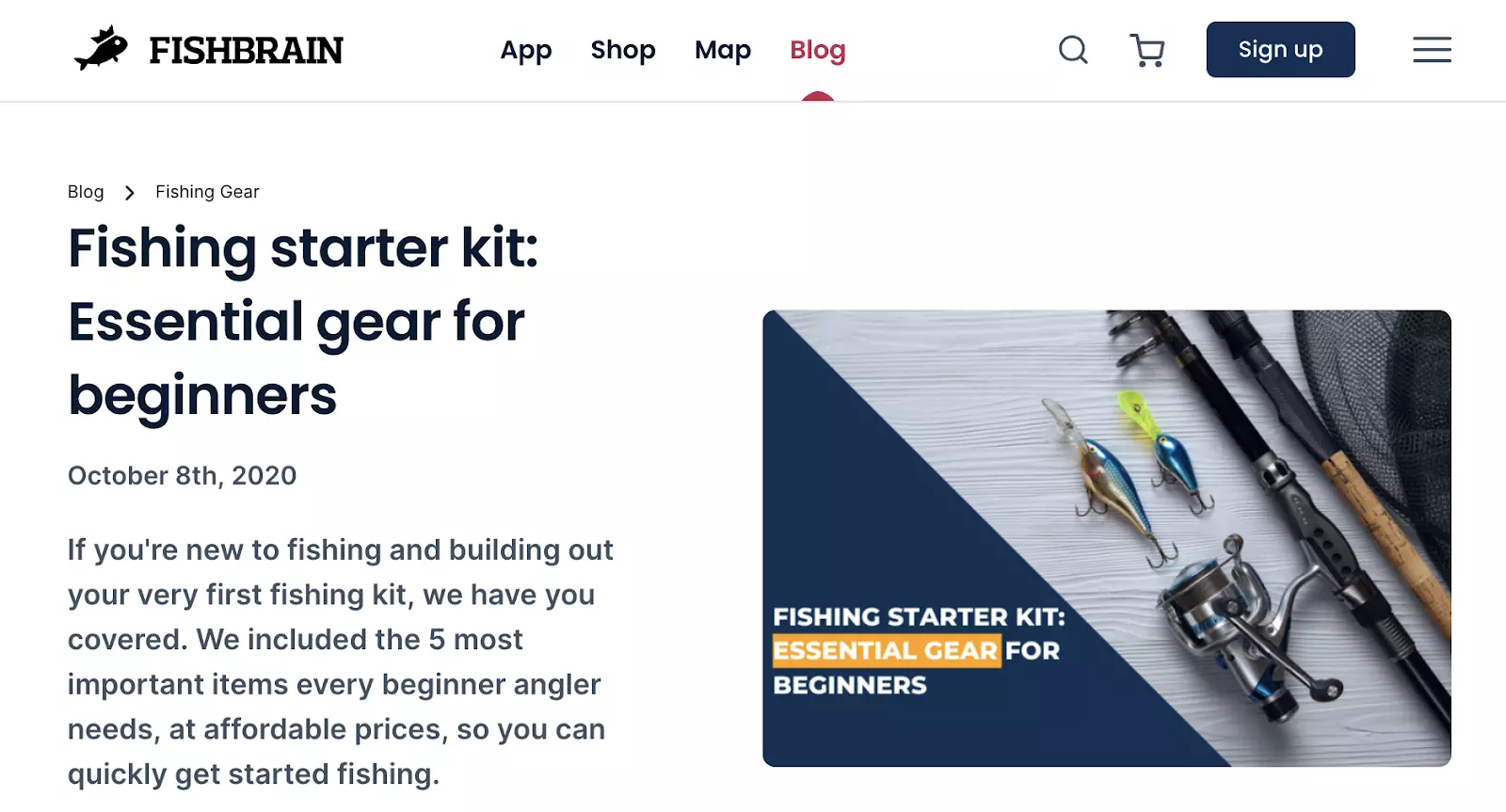

Thanks to SEO optimization, this store ranks #1 for search results related to queries about fishing gear for beginners.
Here’s a screenshot of the ranking for these queries that I took in Ahrefs (a keyword optimization app), please look at the Position column:


Shopify offers various SEO apps that can help you optimize your website for search engines. Some of the key SEO elements you can optimize with these apps include meta descriptions of your product pages, header tags, product images, and category descriptions.
Benefits:
Improve the visibility of your store in search engine results and bring “free” traffic
Provide valuable information to your target audience, building brand awareness and trust
Help attract and engage your target audience through valuable content
Cons:
SEO and content creation are an ongoing process, and it can take time to see results
A successful SEO strategy for a Shopify store should include keyword research, on-page optimization, technical SEO, and link building.
Once the technical aspects are covered you should switch to content production. This can include blog posts, videos, infographics, and more. It is all about creating valuable and informative content that showcases your products in a natural way (Like that Fishing Starter Kit article from Fishbrain!)
Read more:
7. Product Reviews
About 46% of customers trust product reviews as much as recommendations from family and friends. That’s why they can help build trust and credibility with potential customers, increase sales, and improve the overall customer experience.
And they can be treated as user-generated content that you can utilize in your marketing efforts too. You can share reviews like that (on product pages)…


... or sometimes even in Shopify exit campaigns for better review visibility:
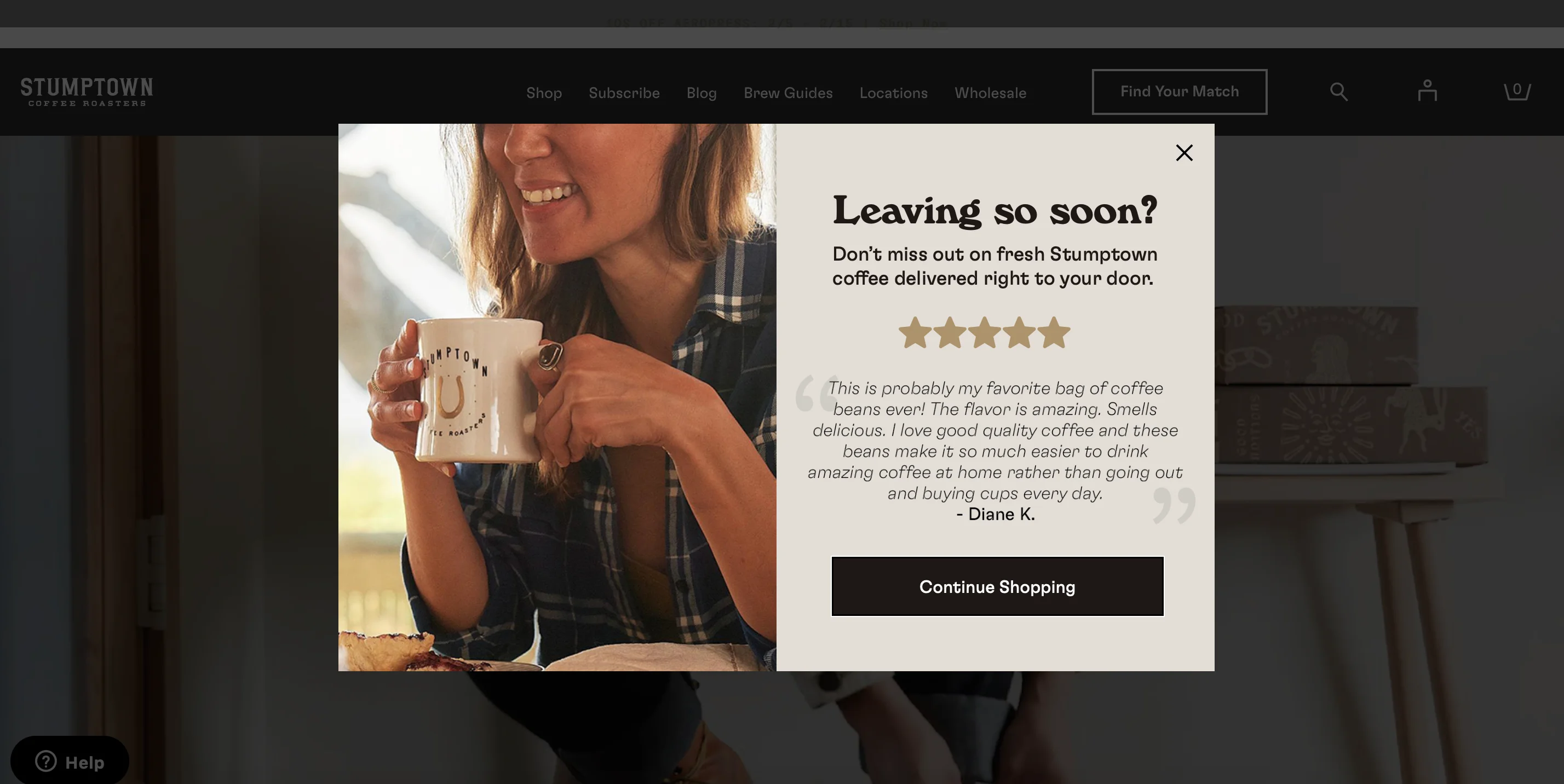

Shopify offers various loyalty program apps that allow you to collect and display product reviews on your store. You can also use email marketing to request product reviews from your customers.
Benefits:
Provides valuable insights into customer satisfaction and the effectiveness of your products
Can help build trust and credibility with potential customers
Can increase sales and improve the overall customer experience
Cons:
Negative reviews can harm your reputation and require a prompt response to mitigate damage
To make the most of product reviews, it's important to respond to both positive and negative feedback in a timely and professional manner. You should also consider offering incentives for customers to write reviews, such as discounts or exclusive access to new products.
And, speaking about discounts…
8. Personalized discounts & gift cards
Discounts can help entice customers to make a purchase, while gift cards provide a convenient and personalized gift option.
The great thing about them is that you can adjust the discounts to make your prices still within the right profit margin. And a gift card, especially a “free” product sample, can be an awesome deal breaker.


You can generate Shopify discount codes in your store admin panel and then reuse the codes in any app you like. For instance, you can create a popup that gives a 20% discount to your new customers for their first purchase.
Benefits:
You can cater to the needs of customers who are looking for a good deal
People are more likely to return to your store to redeem their gift card or a discount code
Some gift cards serve as a physical representation of your brand, increasing visibility and promoting brand awareness.
Cons:
Customers may come to expect promotions and only purchase items when they are on sale
To effectively use discounts and gift cards, it's important to balance the desire to drive sales with the need to protect your profits. You should also consider offering exclusive discounts and gift cards to your most loyal customers, as a way to reward their loyalty and encourage repeat business.
Read more:
9. Affiliate Marketing & Referral Programs
Affiliate marketing and referral programs are two ways to use the power of your satisfied customers to promote your ecommerce store. Affiliate marketing involves partnering with influencers and other businesses to promote your products, while a referral program incentivizes your existing customers to refer friends and family to your store.
Social media is a good place to recruit influencers who can help you advertise your products and become your partners or brand ambassadors.


Combine this strategy with discounts and free samples and you can build an audience really fast.
Benefits:
Reaches a wider audience through trusted influencer partnerships
Provides an incentive for your existing customers to promote your store
Can result in increased sales and brand awareness
Cons:
May require additional resources to manage and maintain the programs
When creating an affiliate marketing program, it's essential to carefully choose your partners and provide them with the tools and resources they need to be successful. A referral program should be designed to incentivize your customers to refer their friends, with rewards such as discounts or store credit.
10. Use Shopify marketing automation tools
Marketing automation tools can help you streamline and optimize many marketing efforts.
For example:
Abandoned cart apps can automatically send a marketing email to customers who have left items in their virtual cart, reminding them to complete their purchase.
Here’s how an automated email marketing workflow looks like (note the various conditions under which the emails are sent):


Some popular marketing automation platforms that you can integrate with Shopify include HubSpot, Platform.ly, and Pardot.
These tools allow you to create automated workflows that trigger actions based on customer behavior. You can also set up advanced rules and schedule long sequences of emails or even SMS & MMS automations.
Benefits:
You can create and schedule campaigns in advance
As the name suggests, once you set things in motion they work (to an extent) automatically
Marketing automation tools provide data and analytics to track your marketing performance, giving you many valuable insights
Cons:
The setup and maintenance of marketing automation workflows can be complicated
Marketing automation can be a powerful tool for Shopify stores, but it requires careful consideration and planning to ensure that it is implemented effectively and efficiently. Still, a tool like HubSpot can become your central “hub” for marketing operations.
Automate cart recovery on Shopify:
11. Seasonal promotions
Seasonal promotions are marketing campaigns that are designed to take advantage of holidays or special occasions throughout the year.
These promotions can engage customers by offering special deals in original ways. And, come to think about it, every time of the year can be an awesome opportunity for a flash sale if you are creative.


One of the most popular seasonal promotions is the holiday shopping season.
For many Shopify store owners, Black Friday and Cyber Monday are the peak point of the year. Other popular seasonal promotions include back-to-school sales, summer discounts, and promotions around major events related to the world of sport or showbusiness.
Benefits:
Using new aesthetics and designs to reach new audiences (like running a series of Halloween ads targeting a new customer segment)
They provide better context and topical focus for your marketing emails
Seasonal promotions give you a great opportunity to differentiate your brand
Cons:
Creating and executing seasonal promotions takes time and resources
To run a successful seasonal promotion, it's important to plan ahead and create a sense of urgency around your offer. Make sure your promotion is relevant to the season and is tied to a specific event or holiday. Use social media, email marketing, and other channels to promote your offer and make sure to track your results so you can learn from your successes and failures.
Read more:
12. Upselling and cross-Selling
Upselling and cross-selling are techniques used to increase the value of each customer transaction by offering complementary or upgraded products.
“Would you like a bigger burger?” is upselling while “Would you like fries with that?” is cross-selling. These techniques can be used to increase average order value and, ultimately, your overall revenue.


Thankfully, in ecommerce you don’t have to ask these questions on your own. There are automatic solutions for that. Shopify offers several apps that can help with upselling and cross-selling. These apps can suggest complementary products or upgrades based on what a customer is currently viewing or has previously purchased.
Benefits:
Increase average order value and overall revenue
Provide valuable recommendations to customers
Streamline the sales process
Cons:
Figuring out your strategy, planning the deals, and setting the rules can be complicated
In order to effectively use upselling and cross-selling, it's important to understand your products and what complementary items would be of value to your customers. You should also be careful not to overuse these techniques, as it can quickly become overwhelming or annoying to your customers.
Related: How to create an upsell popup on Shopify
13. Start a customer loyalty program
It costs 5x more to get a new customer than to get business from an existing one, right?
Apparently, this matter is more complicated in modern ecommerce. Still, customer loyalty programs are a great way to reward your customers for their repeat business and encourage them to continue shopping with your store. These programs can include rewards such as points, discounts, and exclusive offers.


Shopify integrates with many customer loyalty programs, making it easy to add this feature to your store. You can create a loyalty program that rewards customers for purchases, referrals, and other actions, and you can track and manage the program directly from your Shopify dashboard.
Benefits:
Encourage repeat business and customer loyalty
Create a more personal and engaging shopping experience
Generate positive word of mouth and customer referrals
Cons:
Can be expensive and time-consuming to implement and manage
In order to effectively use a customer loyalty program, it's important to understand your customers and what motivates them to participate. This means creating a program that is tailored to your customers' needs. You should experiment with different types of rewards and see what resonates with your customer base.
Learn more: 10 examples of successful customer loyalty programs
14. Retargeting
Retargeting is a marketing strategy that involves showing ads to people who have interacted with your business in some way, such as visiting your website or adding items to their cart. The goal of retargeting is to bring people back to your website and encourage them to take further action, such as making a purchase or filling out a form.
To set up a retargeting campaign, you first need to install a “pixel” on your website, for example, the Meta pixel. It allows you to track the actions of your website visitors and enables you to create custom audiences based on their behavior. Once you have created your custom audiences, you can create retargeting ads that will be shown to these specific groups of people.


Benefits:
You can reach customers who haven’t left any contact information while visiting your store
Retargeting is more effective than showing ads to people who haven’t interacted with your brand
Retargeting ads improve brand awareness by reminding customers about your brand and products even if they don't make a purchase right away
Cons:
Customers may become annoyed with seeing the same ad repeatedly, leading to ad fatigue and a negative impact on your brand
Remember that retargeting campaigns are limited to targeting only those customers who have already visited your website or shown interest in your products. You can create “lookalike” audiences but this may still limit your ability to reach new customers. You should also try to personalize your retargeting ads. If your campaigns are not personalized, they may not be effective. Customers may be less likely to respond to generic ads.
How to choose the best marketing strategy for a Shopify store?
To sum up, here are the most effective marketing ideas for boosting the success of your Shopify store:
Make your website more engaging by adding interactive popups and onsite feed
Send automated email marketing campaigns to keep your customers informed and engaged
Use social media to connect with your customers and build a community around your brand
Optimize your paid advertising campaigns to make the most of your budget
Improve your SEO by creating high-quality content that is engaging and relevant to your customers
Encourage your customers to leave product reviews and use them to showcase your products
Boost conversions by offering discounts and gifts to your customers
Implement a referral program to encourage your customers to spread the word about your brand
Use marketing automation tools to save time and streamline your marketing efforts
Increase your revenue by using cross-selling and upselling plugins
Establish a customer loyalty program to reward your most loyal customers and encourage repeat business
By implementing these strategies, you can improve the customer experience, increase sales, and build a loyal following for your Shopify store.
Get started
in minutes
Start converting more visitors today.
Get started in minutes and see results right after.

